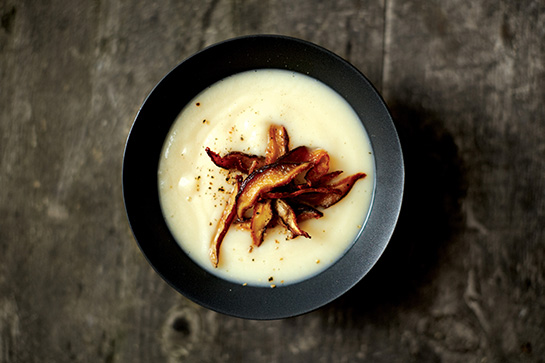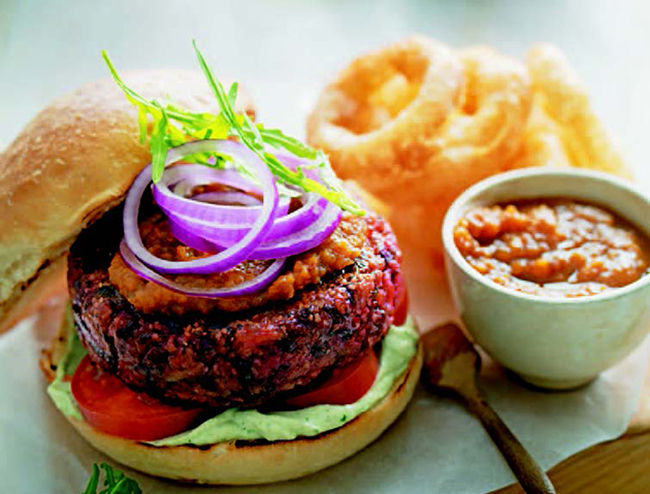Vegan Cookbooks even Omnivores will Crave
Raise your spatula if you ever expected vegan cuisine to gain the popularity and cachet that it has. Almost monthly, new vegan cookbooks from large and small publishers hit my doorstep. Many contain vibrant, innovative recipes, healthy lifestyle advice and plush photos, sometimes with an author cuddling a cow or chicken. That these cookbooks have crossover appeal contributes to the overall popularity of veganism. Non-vegans, as it happens, are the big patrons of vegan and vegetarian cuisine.
Vegan and vegetarian cookbooks naturally have special appeal during harvests. But the criteria for judging vegan cookbooks varies widely. The authors’ background and philosophy are reflected in the recipes and cookbook titles. Is the author a “Vegan with a Vengeance” – Isa Chandra Moskowitz’s newly re-released cookbook – or “At Home in the Whole Food Kitchen” – Amy Chaplin’s largely vegan cookbook, which won a prestigious 2015 James Beard Award?
Moskowitz is a wonderfully loquacious blogger and self-taught cook whose kitchen know-how seems to come from manic experimentations, often with fellow vegan mavens. She aptly describes “Vegan with a Vengeance” (Da Capo Press) as “cheap recipes that rock.” Despite their inventiveness, the recipes may lack the finesse that gourmands crave. There are recipes calling for refined sugar, agave and maple syrup in unexpected places – such as a black-eyed pea curry, carrot bisque, and curried tempeh-mango salad. Nutritional yeast and cashews are used as thickeners and cream substitutes. The fast-food style might be just the thing for vegans prone to long stretches between meals.
Early on, Moskowitz collaborated with Terry Hope Romero in the video series “Post Punk Kitchen.” The authors provide a sense of inclusion in an ethical, mainly youth-oriented movement. Their manifesto is not to be greased with a single pat of butter. Hence, big doses of cashew cream and use of almond butter for anything “cheesy” – like Moskowitz’s New England clam chowder, cheese enchiladas, or Romero’s Cesar salad. Romero has since meandered into more intricate tastes. Her “Salad Samuri” cookbook (Da Capo Press), contains recipes like a seitan-bacon wedge salad of architectural and savory stature. Another with nicely woven tastes is an herb salad with arugula, dill strawberries, radishes and snap peas topped with orange tempeh nibbles.
There is a different level of cooking maturity that comes from formal training. Amy Chaplin was executive chef of the vegan restaurant Angelica Kitchen in New York City. This beloved, innovative establishment on East 12 Street Manhattan has sourced from an array of local organic farmers and artisan ingredient makers long before it was trendy. Its cooking sophistication shows in daily specials, norimaki, three-bean chili, and full-bodied soups, and its special way with a macrobiotic dessert, kanten parfait, with seasonal fruit infusions.
Chaplin’s recipes can teach more than how to make individual dishes. There’s a sensitivity and knowledge to the preparation of grains, beans, nuts, seeds and vegetables. Some of her knowledge is gleaned from macrobiotics, which emphasizes simplicity and balance with attunement to the changing seasons. Photos like the late-summer stew with beans and parsley pistou – and another of a tempeh portobello burger that will make you gasp – represent attainable goals. Chaplin’s “At Home in the Whole Food Kitchen” (Roost Books) may contain her favorite recipes, but they aren’t a random collection. One recipe leads you to the next.
But do pity the ambitious vegan cook who wants formal restaurant training. Vegan cookbooks abound, but a scant number of vegan restaurants exist nationwide. Vegan cookbooks are a far greater proportion of all cookbooks than vegan restaurants are to all restaurants.
Many restaurants, of course offer vegan and vegetarian options. But of the handful of New Hampshire vegan restaurants visited in 2012 by Kristin Lajeunesse, author of “Will Travel for Vegan Food” (Vegan Publishers), only Susty’s Cafe in Northwood and The Juicery in Portsmouth still stand. A third, Willows Plant-Based Eatery in Concord, has since sprung up, a vegan-vegetarian, The Country Life Restaurant, is in Keene and Zeppelin & Kaleidoscope is in Marlborough.
Attracting a non-vegan following is key to survival for such eateries. “One of the most consistent things I hear from vegan restaurant owners, is that 90 percent-ish of their customer base, and regulars, are not vegan. So, I’d say that’s pretty darn important, the non-vegan community,” Lajeunesse told me via email.
Non-vegan interest is also essential for vegan cookbooks. Says Anna Mintz, assistant director of publicity at Clarkson Potter, “Even though the number of vegans and vegetarians is growing, they still represent a small percentage of the population and cookbook buying public.” Mintz says it’s clear from sales that non-vegans are attracted, especially to celebrity vegan authors.
The adaptation of a vegan diet for healthy living is a big draw for nonvegans. Food writer Mark Bittman, in his quest to lose weight and get healthy, devised a diet of eating vegan until 6 p.m.; He coined the term Vegan Before 6. While some nutritionists and medical doctors were exposing the vegan diet, Bittman’s “VB6” cookbook (Clarkson Potter) helped dash into popularity the virtues of part-time veganism. “Bittman lays out the benefits of a vegan diet and leaves it to the reader to decide how far they want to take it,” says Mintz.
It may all be part of a move toward giving vegetables a starring role, a trend that coincides with consuming less meat in general. Vegetables no longer play second fiddle to meat. “In a lot of ways,” says Mintz, “it’s more rewarding to coax amazing flavor out of a head of cauliflower or an eggplant, or an unusual grain, than it is to cook a big hunk of meat.”
Beetroot, fennel, apple and dill burger, from “Mildred’s: The Vegetarian Cookbook,” courtesy of Mitchell Beazley. Recipe is on Page 14.
Having crossover appeal isn’t a criterion at Da Capo Press, which has published dozens of vegan titles. Says Lissa Warren, VP senior director of publicity, “The vegan community is large and strong, and we know how to reach them. That said, the vegan community is full of people who are already savvy about how to prepare good food. So the recipes have to be innovative and unique, even to seasoned vegans.”
Likewise, Chaplin doesn’t make a conscious effort to appeal to meat-eaters.
“I know that good food presented in an elegant way is appealing to anyone who loves delicious food,” she says. “I never thought of my food not appealing to nonvegetarians. In my experience, avid meat eaters also love well-prepared vegetables.”
There are plenty of us who want to be vegan or vegetarian and have our meat too. Vegans especially need to stop playing cover-up for no meat or dairy with contrived substitutions. Cookbooks focused on celebrating the bounty, wholesomeness and depth of flavor of nonmeat options have greater secular appeal.
It may even be a lesson for the committed vegans hoping to expand the vegan flock. Says Norma Koski, chef-owner of Sustys, “So many people, when they try my cooking, say ‘I would be vegan if it tasted like this.’”

